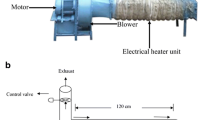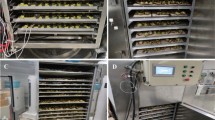Abstract
The drying characteristics of tapioca sago were studied using four different drying methods—Open sun drying (OSD), Conveyor belt drying (CBD), Bin drying (BD) and Fluidized bed drying (FBD)—in an industry located in Tamilnadu, India (Latitude: 11.494347° N; Longitude: 78.272264° E). The BD and FBD dryers were designed and fabricated as pilot scale models in the laboratory with respective capacity of 5 kg/h and 10 kg/h; CBD (1000 kg/h) and OSD are the commercial drying operations currently employed in industrial processing. The drying time, energy and exergy aspects of all the drying methods were compared along with the achieved final moisture content, color and quality of the dried products. The highest Energy utilization ratio (EUR) was found in CBD and FBD in the range of 20-76 % and 10-67 %, respectively. The exergy efficiency was initially low in all the cases but increased to 80 % towards the end of the drying process.
Similar content being viewed by others
References
K. Amuthavalli, Problems and prospects of sago industry in Tamilnadu, Doctoral Thesis, Annamalai University, India (2012).
Web reference, http://www.sagoserve.com/, Last accessed in December (2016).
H. Konuma, R. Rolle and S. Boromthanarat, Color characteristicRs of sago starch as they relate to the growth environment of the sago palm, J. of Agricultural Technology, 8 (3) (2012) 273–287.
E. Barati and J. A. Esfahani, A new solution approach for simultaneous heat and mass transfer during convective drying of mango, J. of Food Engineering, 102 (1) (2011) 302–309.
E. Barati and J. A. Esfahani, Mathematical modeling of convective drying: Lumped temperature and spatially distributed moisture in slab, Energy, 36 (3) (2011) 2294–2301.
J. A. Esfahani, S. M. Vahidhosseini and E. Barati, Threedimensional analytical solution for transport problem during convection drying using Green’s function method (GFM), Applied Thermal Engineering, 85 (1) (2015) 264–277.
S. M. Vahidhosseini, E. Barati and J. A. Esfahani, Green’s function method (GFM) and mathematical solution for coupled equations of transport problem during convective drying, J. of Food Engineering, 187 (1) (2016) 24–36.
A. Isaac Bamgboye and B. S. Kosemani, Energy input in the production of Cassava, Energy and Environment Research, 5 (1) (2015) 42–48.
S. O. Jekayinfa and J. O. Olajide, Analysis of energy usage in the production of three selected Cassava-based foods in Nigeria, J. of Food Engineering, 82 (1) (2007) 217–226.
S. H. Sarker, M. N. Ibrahim, N. A. Aziz and M. S. Punan, Energy and exergy analysis of industrial fluidized bed drying of paddy, J. of Energy, 84 (6) (2015) 131–138.
T. Y. Tunde-Akintunde, Mathematical modelling of thin layer sun and solar drying of Cassava chips, J. of Food Engineering, 6 (1) (2010) 1–20.
T. Kudra, Energy aspects in drying, J. of Drying Technology, 22 (2) (2004) 917–932.
R. M. Torrez Irigoyen and S. A. Giner, Drying-toasting of presoaked soybean in fluidized bed-modeling, validation and simulation of operational variants for reducing energy consumption, J. of Food Engineering, 171 (4) (2016) 78–86.
D. Evin, Microwave drying and moisture diffusivity of white mulberry: Experimental and mathematical modeling, J. of Mechanical Science and Technology, 25 (10) (2011) 2711–2718.
A. Motevali, S. Minaei, A. Banakar, B. Ghobadian and M. H. Khoshtaghaza, Comparison of energy parameters in various dryers, J. of Energy Conversion and Management, 87 (3) (2014) 711–725.
J. P. Sitompul and I. N. Istadi, Widiasa, Modeling and simulation of deep-bed grain dryers, J. of Drying Technology, 19 (2) (2001) 269–280.
A. N. Dimitriadis and C. B. Akritidis, A model to simulate chopped alfalfa drying in a fixed deep bed, J. of Drying Technology, 22 (1) (2004) 479–490.
S. A. Lawrence, A. Pole and G. N. Tiwari, Performance of a solar crop dryer under PNG climatic conditions, J. of Energy Conversion and Management, 30 (1) (1990) 333–342.
E. Kavak Akpinar, Mathematical modelling and experimental investigation on sun and solar drying of white mulberry, J. of Mechanical Science and Technology, 22 (2008) 1544–1553.
M. Kumar, S. K. Sansaniwal and P. Khatak, Progress in solar dryers for drying various commodities, J. of Renewable and Sustainable Energy Reviews, 55 (1) (2016) 346–360.
E. K. Akpinar, Mathematical modelling of thin layer drying process under open sun of some aromatic plants, J. of Food Engineering, 77 (2) (2006) 864–870.
S. Kooli, A. Fadhel, A. Farhat and A. Belghith, Drying of red pepper in open sun and greenhouse conditions by/ with mathematical modeling and experimental validation, J. of Food Engineering, 79 (2) (2007) 1094–1103.
A. S. Mujumdar and S. V. Jangam, Some Innovative Drying Technologies for Dehydration of Foods, https://www.academia.edu/1355244, Last accessed in December (2016).
O. Corzo, N. Bracho, A. Vasquez and A. Pereira, Energy and exergy analyses of thin layer drying of coroba slices, J. of Food Engineering, 86 (2) (2008) 151–161.
A. Akbulut and A. Durmus, Energy and exergy analyses of thin layer drying of mulberry in a forced solar dryer, J. of Energy, 35 (1) (2010) 1754–1763.
X. Jin, R. G. M. Van der Sman, G. Van Straten, R. M. Boom and A. J. B. Van Boxtel, Energy efficient drying strategies to retain nutritional components in broccoli, J. of Food Engineering, 123 (5) (2014) 172–178.
M. S. H. Sarker, M. Nordin Ibrahim, N. Ab Aziz and M. P. Salleh, Energy and rice quality aspects during drying of freshly harvested paddy with industrial inclined bed dryer, J. of Energy Conversion and Management, 77 (2) (2014) 389–395.
Web reference, http://sabuindia.com/sago4.html, Last accessed in December (2016).
Author information
Authors and Affiliations
Corresponding author
Additional information
Recommended by Associate Editor Youngsuk Nam
Sivakumar R. is doing research in development of low carbon technologies for storage and drying of food products at Anna University, Chennai, India. His research interests include GAX based vapor absorption system, hot air drying, freeze drying and combined power and cooling.
Rights and permissions
About this article
Cite this article
R., S., A., E. & R., S. Drying and energy aspects of tapioca sago processing-an experimental field study. J Mech Sci Technol 31, 3035–3042 (2017). https://doi.org/10.1007/s12206-017-0547-9
Received:
Revised:
Accepted:
Published:
Issue Date:
DOI: https://doi.org/10.1007/s12206-017-0547-9




